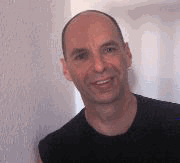Lecture 30
This Week:
Alan Mathison Turing
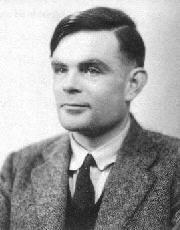
June 23, 1912 - June 7, 1954
Lecture 30
This Week:
Alan Mathison Turing

June 23, 1912 - June 7, 1954
Tuesday: Discuss "Computing
Machinery and Intelligence" Mind: A Quarterly Review of Psychology and
Philosophy, Volume LIX, Number 236: October 1950
Wednesday/Friday: "Breaking
the Code" by Hugh Whitemore. Stageplay: 1986; Television adaptation: 1996.
Andrew Hodges: Alan Turing: the Enigma, (Walker and Company, New York), 2000.
(Alan Turing: The Enigma
of Intelligence, Burnett Books, London, 1983)
Paul Strathern, Turing
and the Computer, Anchor Books, New York, 1997.
The Collected Works of A. M. Turing
Mechanical Intelligence, ed. Darrel Ince, ISBN 0-444-88058-5, 1992
Morphogenesis, ed. P. T. Saunders, ISBN 0-444-88486-6, 1992
Pure Mathematics, ed. J. L. Britton, ISBN 0-444-88059-3, 1992
Mathematical Logic, ed. R. O. Gandy, C. E. M. Yates, ISBN: 0-444-50423-0, May 2001
North-Holland (Amsterdam; London).
|
|
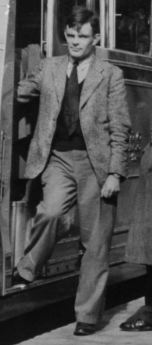 |
Three of Turing's Major Accomplishments
1) He mapped out the theory of computers before a single computer had been conceived.
"On computable numbers, with an application to the Entscheidungsproblem, Proceedings of the London Mathematical Society, Ser. 2 42 (1936), 230--265.
2) He broke the German Enigma Codes, saving Britain in World War II.
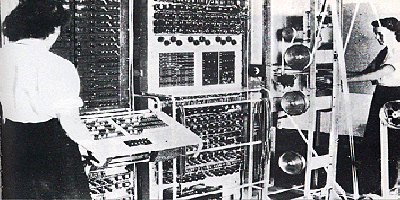
3) He established and
set the agenda for the field of Artificial Intelligence.
| 1912
1926-31 1930 1931-34
1932-35
1935 |
Birth,
Paddington, London
Sherborne School Death of friend Christopher Morcom Undergraduate at King's College, Cambridge University Studies quantum mechanics, probability, logic Elected fellow of King's College, Cambridge |
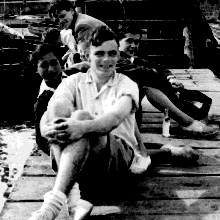 |
| 1936 | The Turing machine; On Computable Numbers... submitted | |
| 1936-38 | At Princeton University. Ph.D. Papers in logic, algebra, number theory | |
| 1938-39 | Return to Cambridge. Introduced to German Enigma cipher problem | |
| 1939-40 | Devises the Bombe, machine for Enigma decryption | |
| 1939-42 | Breaking of U-boat Enigma cipher, saving battle of the Atlantic | |
| 1943-45 | Chief Anglo-American consultant. Introduced to electronics | |
| 1945 | National Physical Laboratory, London | |
| 1946 | Computer design, leading the world, formally accepted | |
| 1947-48 | Papers on programming, neural nets, and prospects for artificial intelligence | |
| 1948 | Manchester University | |
| 1949 | Work on programming and world's first serious use of a computer | |
| 1950 | Philosophical paper on machine intelligence: the Turing Test | |
| 1951 | Elected FRS. Paper on non-linear morphogenesis theory | |
| 1952 | Arrested and tried as a homosexual, loss of security clearance | |
| 1953-54 | Unfinished work in biology and physics | |
| 1954 | Death by cyanide poisoning, Wilmslow, Cheshire. |
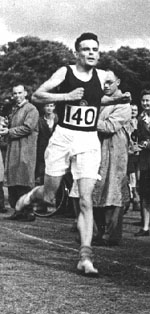
Are There Tasks A Computer Cannot Do?
The
Halting Problem: Is it possible to create an "infinite loop
detector" ?
Can a program be written that can analyze whether any program presented to it contains an infinite loop or not?
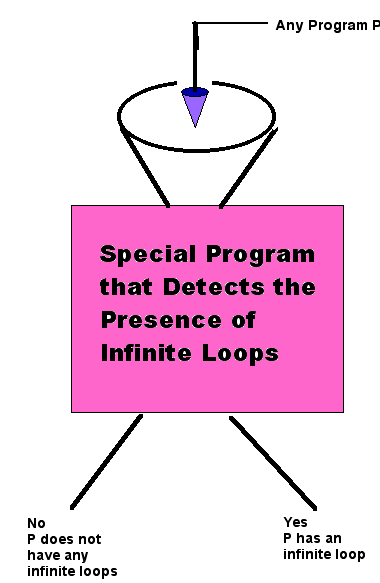
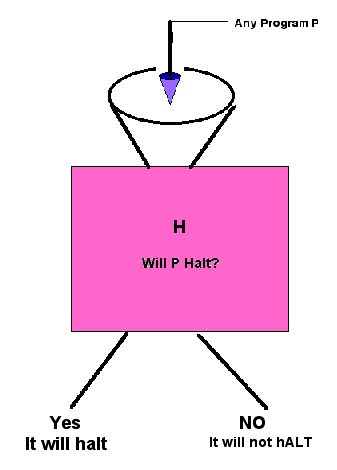
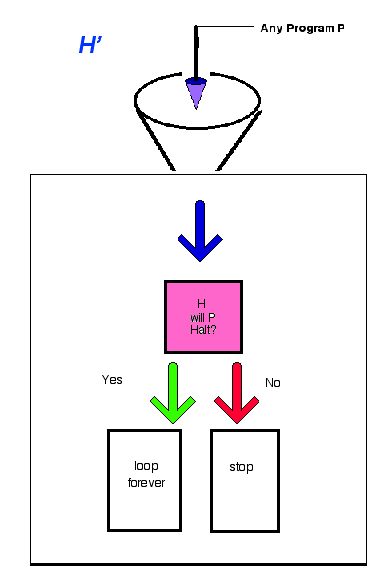
1) If a program P has no infinite loops
(that is, P
eventually halts) then H' loops forever.
2) If a Program P
has an infinite loop (that is, P
does not halt), then H' halts.
NOW.... H' will work for
any program P.
H'
is itself a program.
What happens if H' is fed into H'?
(1) If H' has no infinite loops, then H' loops forever.
(2) If H'
has infinite loop, then H' halts.
H' will halt
if and only if
H'
does not halt
THE HALTING PROBLEM
CAN NOT BE SOLVED BY A COMPUTER
Turing Machines and Computability
The Turing machine concept
involves specifying a very restricted set of logical operations which are,
however, sufficient to encompass anything that in modern terms would be
called an algorithm.
Turing argued that his formalism was sufficiently general to encompass anything that a human being could do when carrying out a definite method.
The Universal Machine
He had the further idea of the Universal Turing Machine, capable of simulating the operation of any Turing machine.
A Universal machine is a Turing machine with the property of being able to read the description of any other Turing machine, and to carry out what
that other Turing machine would have done.
Turing gave an exact description of such a UTM in his paper
A Turing machine is a very simple machine, but, logically speaking, has all the power of any digital computer.
A Turing machine processes an infinite tape.
This tape is divided into
squares, any square of which may contain a symbol from a finite alphabet,
with the restriction that there can be only finitely many non-blank squares
on the tape.
| 1 | 1 | 0 | 0 | 0 | 1 | 1 | 1 | 0 | 0 | 1 | .... |
At any time, the Turing machine has a read/write head positioned at some square on the tape.
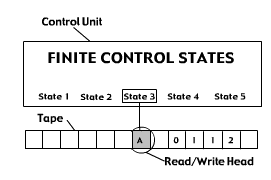
Furthermore, at any time, the Turing machine is in any one of a finite number of internal states. The Turing machine is further specified by a set of instructions of the following form:
(current_state, current_symbol, new_state, new_symbol, left/right)
This instruction means that if the Turing machine is now in current_state, and the symbol under the read/write head is current_symbol, change its
internal state to new_state, replace the symbol on the tape at its current position by new_symbol, and move the read/write head one square in the given
direction (left or right). If a Turing machine is in a condition for which it has no instruction, it halts.
Nowadays it is natural to think of the set of instructions as a program for the Turing machine.
There are several conventions commonly used in Turing machines We adopt the convention that numbers are represented in unary notation, i.e., that the non-negative integer n is represented by a string of n+1
successive 1's.
If we want to compute a function f(n1,n2, ... ,nk), we assume that initially the tape consists of n1, n2, ... , nk, properly encoded, with each separated from the previous one by a single blank, and with the tape head initially poised over the left-most bit of the first argument, and the state of the Turing machine some initial specified value.
We say that the Turing machine has computed
m = f(n1,n2, ... ,nk)
if, when the machine halts, the tape consists of n1, n2, ... , nk, , m, properly encoded, and separated by single blanks, and the read/write head back at the left-most bit of the first argument.
For example, suppose we wish to create a Turing machine to compute the function
m = multiply(n1,n2) = n1 * n2
Suppose the input tape reads
_<1>1 1 1 _ 1 1 1 1 1 _ _ _ _ _ _ _ _ _ _ _ _ _ _ _ _ _ _ _
which encodes 3 and 4 respectively, in unary notation. (Here the position of the read/write head is marked.) Then the Turing machine should halt with its
tape reading
_<1>1 1 1 _ 1 1 1 1 1 _ 1 1 1 1 1 1 1 1 1 1 1 1 1 _ _ _ _ _
which encodes 3, 4, and 12 in unary notation.
The very simplicity of
a Turing machine makes it a challenge to program one to perform a specific
computation.
# Turing machine to multiply two numbers:
# Number n is represented by string of n+1 1's.
# Initially, tape is assumed to be in form of _n1_n2_ (where _ is blank),
# and head is assumed to be positioned at leftmost non-blank square.
# Initial internal machine state is "start".
# At halt, tape is _n1_n2_n3_, where n3=n1*n2,
# and head is positioned at leftmost non-blank square.
start, 1, move1right, W, R # mark first bit of 1st argument
move1right, 1, move1right, 1, R # move right til past 1st argument
move1right, _, mark2start, _, R # square between 1st and 2nd arguments found
mark2start, 1, move2right, Y, R # mark first bit of 2nd argument
move2right, 1, move2right, 1, R # move right til past 2nd argument
move2right, _, initialize, _, R # square between 2nd argument and answer found
initialize, _, backup, 1, L # put a 1 at start of answer
backup, _, backup, _, L # move back to leftmost unused bit of 1st arg
backup, 1, backup, 1, L # ditto
backup, Z, backup, Z, L # ditto
backup, Y, backup, Y, L # ditto
backup, X, nextpass, X, R # in position to start next pass
backup, W, nextpass, W, R # ditto
nextpass, _, finishup, _, R # if square is blank, we're done. finish up
nextpass, 1, findarg2, X, R # if square is not blank, go to work. mark bit
findarg2, 1, findarg2, 1, R # move past 1st argument
findarg2, _, findarg2, _, R # square between 1st and 2nd arguments
findarg2, Y, testarg2, Y, R # start of 2nd arg. skip this bit, copy rest
testarg2, _, cleanup2, _, L # if blank, we are done with this pass
testarg2, 1, findans, Z, R # if not, increment ans. mark bit, move there
findans, 1, findans, 1, R # still in 2nd argument
findans, _, atans, _, R # square between 2nd argument and answer
atans, 1, atans, 1, R # move through answer
atans, _, backarg2, 1, L # at end of answer--write a 1 here, go back
backarg2, 1, backarg2, 1, L # move left to first unused bit of 2nd arg
backarg2, _, backarg2, _, L # ditto
backarg2, Z, testarg2, Z, R # just past it. move right, and test it
backarg2, Y, testarg2, Y, R # ditto
cleanup2, 1, cleanup2, 1, L # move back through answer
cleanup2, _, cleanup2, _, L # square between 2nd arg and answer
cleanup2, Z, cleanup2, 1, L # restore bits of 2nd argument
cleanup2, Y, backup, Y, L # done with that. backup to start next pass
finishup, Y, finishup, 1, L # restore first bit of 2nd argument
finishup, _, finishup, _, L # 2nd argument restored, move back to 1st
finishup, X, finishup, 1, L # restore bits of 1st argument
finishup, W, almostdone, 1, L # restore first bit of 1st arg. almost done
almostdone, _, halt, _, R # done with work. position properly and halt
sample output:
http://www.ams.org/new-in-math/cover/turing_multiply_output.html
"Breaking the Code" Film
GCCS = Goverment Code and Cipher School
A. Dilwyn Knox: Classical Scholar at Cambridge
Lytton Strachey
John Maynard Keynes
Bertrand Russell, Principia Mathematica
Kurt Gödel
David Hilbert
Ludwig Wittgenstein
Patricia Green = Joan Clarke
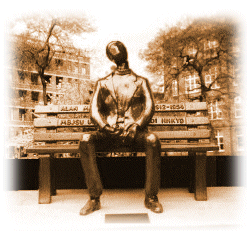 |
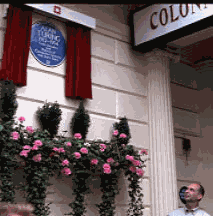 |
| Alan
Turing Memorial
Sculptor: Glyn Hughes, Contractors: Focus Arts |
Andrew
Hodges unveils
Turing Plaque at his birthplace |
